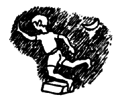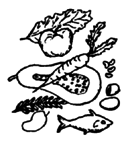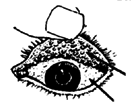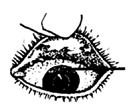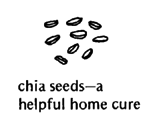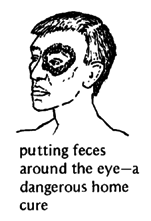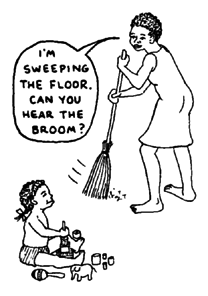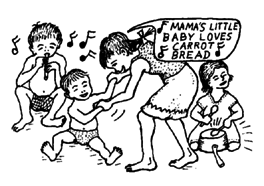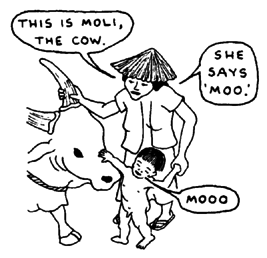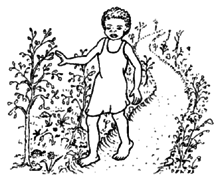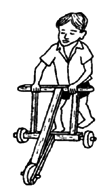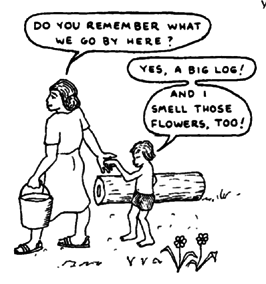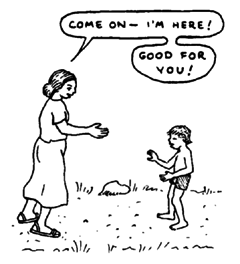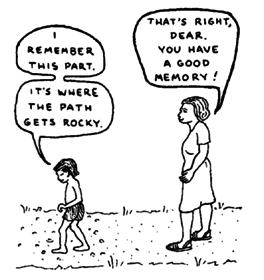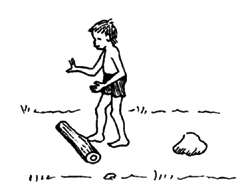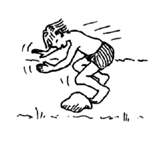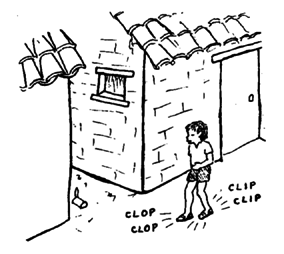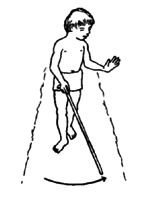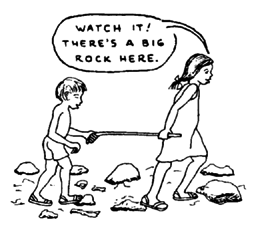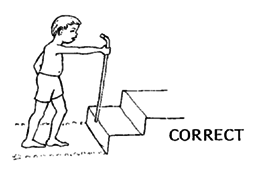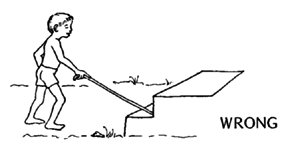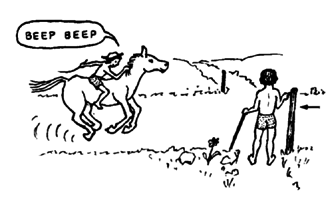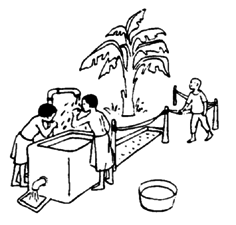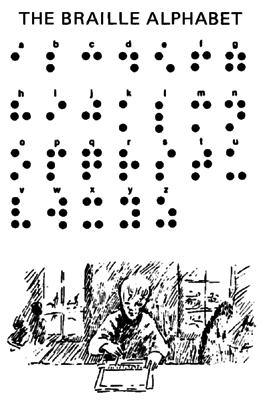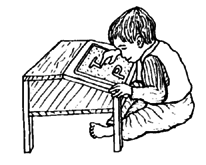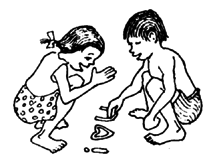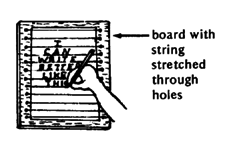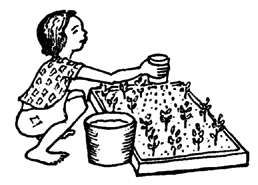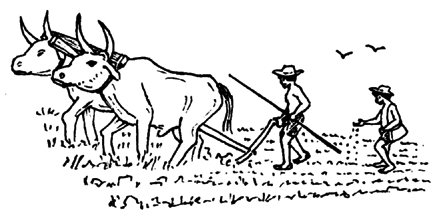Disabled Village Children
A guide for community health workers,
rehabilitation workers, and families
PART 1
WORKING WITH THE CHILD AND FAMILY:
Information on different Disabilities
B. Recognizing, Helping with, and Preventing Common Disabilities
CHAPTER 30
Blindness and Difficulty Seeing
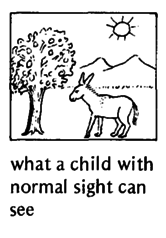
Difficulty with seeing can be mild, moderate, or severe. When a person sees very little or nothing, we say he is blind. Some children arecompletely blind; they cannot see anything. However, most blind children can see a little. Some can only see the difference between light and dark or day and night, but cannot see any shapes of things. Others can see shapes of large objects, but none of the details.
Many more children are not blind but do have some problem seeing things clearly. For example, they may see fairly well for most daily activities, but have trouble seeing details. The family may not realize that the child has a seeing problem until they notice she has difficulty threading a needle, finding head lice, or reading letters on the blackboard at school. Often these children can see much better with eyeglasses or a magnifying glass. (Children who are completely blind cannot see at all, even with eyeglasses.)
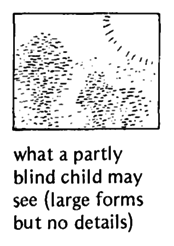
Some children are born blind. Others become blind during early childhood, or later.
|
CAUTION: Not all children who are blind have eyes that look different. Their eyes may look clear and normal. The damage may be behind the eyes or in part of the brain. So be sure to watch for other signs that can tell you if a child has difficulty seeing. |
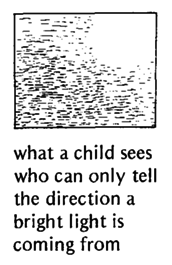
SIGNS THAT COULD MEAN A CHILD HAS A SEEING PROBLEM
- Eyes or eyelids are red, have pus, or continually form tears.
- Eyes look dull, wrinkled, or cloudy, or have sores or other obvious problems.
- One or both pupils (the black center of the eye) looks gray or white.
- By 3 months of age, the child's eyes still do not follow an object or light that is moved in front of them.
- By 3 months the child does not reach for things held in front of him, unless the things make a sound or touch him.
- Eyes 'cross', or one eye turns in or out, or moves differently from the other. (Some eye-crossing is normal up to 6 months.)
- Child squints (half shuts his eyes) or tips head to look at things.
- Child is slower to begin using his hands, move about, or walk than other children, and he often bumps into things or seems clumsy.
- Child takes little interest in brightly colored objects or pictures and books, or she puts them very close to her face.
- Has difficulty seeing after the sun sets (night blindness).
- In school, the child cannot read letters on the blackboard. Or he cannot read small print in books, or gets tired or often gets headaches when he reads.

If the child shows any of these signs, test her vision, and if possible, see a health worker or eye doctor. Sometimes eyesight can be saved by preventive steps or early treatment (see Page 245).
Methods for testing if a baby sees and for measuring the vision of children are discussed with CHILD-to-child activities on Page 452 and 453.
Blindness with other disabilities
Some children with cerebral palsy or other disabilities are also partly or completely blind. Parents may not realize this and think that the child's slow development or lack of interest in things is because he is mentally and physically handicapped. In fact, blindness may be a large part of the cause.
Even if a child has no other disability, blindness can make development of early skills slower and more difficult. If the child does not look at, reach for, or take interest in things around him, check if he can see (and hear).
|
Note: Some children with very severe brain damage or mental retardation may seem blind. They may look at things without really seeing them, because their brains are at the developmental level of a newborn baby. With lots of stimulation, little by little some of these children begin to become more aware of things, to follow them with their eyes, and finally to reach for them. |
Causes of blindness
Different people have different beliefs about what causes blindness. In some parts of the world, people think a child is born blind as punishment for something the parents have done. In parts of Latin America, villagers believe that a bat's urine fell in the baby's eyes, or that a 'black witch moth' flew by the baby's face. These things do not really cause blindness, and as people get new information, many are leaving these older beliefs behind.
We now know that child blindness is usually caused by poor nutrition or infection, and that most blindness in children can be prevented.
COMMON CAUSES OF BLINDNESS IN CHILDREN ARE:
1. 'Dry eyes' (xerophthalmia, or nutritional blindness) is the most common cause of child blindness. It is especially common in parts of Africa and Asia. It results when a child does not get enough vitamin A, which occurs naturally in many fruits and vegetables (and also in milk, meats, and eggs). 'Dry eyes' develops in children who are not regularly fed any of these foods. It often appears or quickly gets worse when these children get diarrhea or have measles, whooping cough, or tuberculosis. It is much more common in children who are not breast-fed.
Dry eyes can be prevented by feeding children foods with vitamin A. Encourage families to grow and eat things like papaya, squash, carrots, and leafy green vegetables in a family garden. Be sure the child eats these foods regularly, beginning at 4 to 6 months old.
Vitamin A capsules can also prevent dry eyes, but should not take the place of a well-balanced diet. Give 200,000 units (60 mg. retinol) once every 6 months (or 100,000 units to babies less than 1 year old). Do not give this large dose more often than 6 months, because too much vitamin A can poison the child. For treatment, give 200,000 units (1. U.) of vitamin A at once, 200,000 1. U. the next day, and 200,000 I.U. 2 weeks later. Give half the dose to children under age 1. See a health worker.
|
SIGNS OF XEROPHTHALMIA First sign may be night blindness. Child sees worse than others in the dark.
Next the eyes look 'dry'. The white part loses its shine, begins to wrinkle, and forms patches of little gray bubbles (Bitot's spots).
Later, the dark part (cornea) also gets dry and dull, with little pits.
Finally, the cornea may get soft, bulge, or burst, causing blindness.
FOODS THAT HELP PREVENT IT
|
2. Trachoma is the commonest cause of preventable blindness in the world. It often begins in children and may last for months or years. If not treated early, it can cause blindness. It is spread by touch or flies and is most common in poor crowded living conditions.

Trachoma can often be prevented by keeping the child's eyes clean and keeping flies away. To prevent blindness from trachoma, treat early with tetracycline eye ointment (see a health worker, or Where There Is No Doctor, Page 220).
|
SIGNS OF TRACHOMA
|
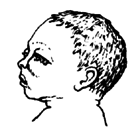
3. Gonorrhea in the eyes of newborn babies causes blindness if not treated immediately. The baby gets the infection from his mother at birth. The eyes get red, swell, and have a lot of pus. It can be prevented by putting tetracycline eye ointment or a drop of 1% silver nitrate solution in the eyes of all babies at birth. Gonorrhea, which is a very common venereal (sexually spread) disease, can sometimes be treated with penicillin (see Where There Is No Doctor, Page 221 and 236).
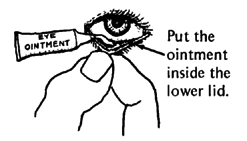
4. 'Chlamydia' is a venereal disease caused by the same virus as trachoma. It is similar to gonorrhea, both in the genitals and the eyes, and is rapidly spreading worldwide. Putting tetracycline ointment in the eyes of a newborn baby 3 times a day for 3 days usually prevents eye damage from both gonorrhea and chlamydia.

5. River blindness (onchocerciasis) is a very common cause of blindness in parts of Africa and Latin America. (See Where There is No Doctor, Page 227.) It is spread by a kind of black fly that breeds in rivers and streams. There is no cure.
6. Measles, which can injure the surface of the eyes, is a common cause of blindness, especially in Africa and in children who are poorly nourished.
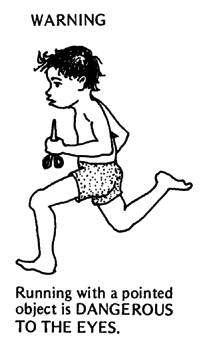
7. Brain damage causes blindness in many children, usually in combination with cerebral palsy or other disabilities. Brain damage can happen before, during, or after birth. Causes include German measles during pregnancy, delayed breathing at birth, and meningitis. See Page 91.
8. Eye injuries often cause blindness in children. Pointed tools, fireworks, acid, lye, and homemade bombs to dynamite fish are common causes.
9. Also, blindness in children is sometimes caused by other problems such as hydrocephalus (see Page 169), arthritis (see Page 136), leprosy (see Page 219), brain tumors, or certain medicines (see Page 246). Cataracts (clouding of the lens inside the eye) gradually develop in about half of older children with Down Syndrome.
|
WARNING ON USE OF EYE MEDICINES Only use modern medicines or 'home cures' that you are sure cannot damage the eyes. One modern medicine that should not be used often, and only with great caution, is corticosteroid eye ointment. Some doctors and health workers prescribe it for almost any eye irritation. This is a dangerous mistake. If the irritation is caused by a virus (tiny germ), this ointment could make the infection worse and lead to eye damage or blindness!*
Some 'home cures' for eye problems are safe and effective. For example, in Mexico when villagers get a small piece of dirt or sand in the eye, to remove it they put a wet chia seed under the eyelid. The smooth seed has a layer of sticky mucus on it, to which the dirt sticks. Then they remove the seed. This is a safe, good home cure.
Some home cures are dangerous. Some villagers try to treat 'blurred vision' by putting human feces (shit) around the eye. This is unsafe and does not help. It could lead to dangerous infection. It is also dangerous to put lemon juice, urine, pieces of abalone shell, or Vicks ointment in the eye. *Note: Corticosteroid drops or ointment are important medicine for preventing blindness from iritis (see "Arthritis" and "Leprosy"). But tests with 'fluorescein' should be done first to be sure there is not a virus infection. Get medical advice. |
What is the future for a blind child?
With help and encouragement from family and community, a child who is blind can usually develop early skills as quickly and as well as other children. He can learn to feed, bathe, dress, and care for himself, and to find his way around the home and village without help. Although he cannot see well, he develops an outstanding ability to use his sense of hearing, touch, and even smell. If he can see at all, he can be helped to make the best use of whatever vision he has. He can and should go to school. Although he may not be able to read ordinary writing, he can develop his memory.
As he grows up, he can become a farmer, or a craftsperson. And if he has the opportunity for training, he can learn any of a wide variety of skills. Where blind persons are given a fair chance, they often take active part in their communities and can live full, happy lives. In many countries, blind people have been leaders in organizing disabled persons to become more self-reliant and to work toward their rightful place in society.
Unfortunately, blind children often are not given a chance to develop as quickly or as fully as they could. In some countries more than half of the children who are born blind die of hunger or neglect before they are 5 years old. On the next page are 2 stories of blind children that will help you realize the difference that understanding and help from family and community can make.
SHANTI*
Shanti is a little blind girl, who was born in a small village in India. When they found that she was blind, her parents and grandparents tried to hide the fact from the other villagers. They thought all blindness was sent to a family as a punishment for sin, and that people would look down on them.
Secretly her parents took Shanti to an orphanage and left her there.
Nobody in the orphanage had ever cared for a blind child, and they did not know what to do. There were so many other children who needed care, that there was no time left for her.
Shanti was kept alive, but that was all. Nobody talked to her or held her lovingly or tried to stimulate her. Her blind eyes made the nurses think she could not understand or recognize anything around her. So when other babies began to reach out for objects they saw, and then to crawl toward things they wanted, Shanti was left lying silently on her cot.
People got used to the blind child. She was picked up when necessary, and cleaned and fed. They fed her with a bottle, or pushed food into her mouth. But nobody tried to teach her how to feed herself or how to walk and talk.
As she grew older, Shanti spent most of her time sitting on the doorstep, rocking herself and poking her eyes (see Page 364). She never said a word and only cried when she was hungry. Other children stayed away from her; they were afraid of her dead eyes. Everyone thought she was mentally retarded and that nothing could be done about it.
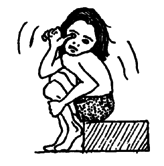
In time, Shanti did begin to talk and walk. But the sad, stony look on her face never disappeared. Now, at age 7 she is in some ways still like a 2-year-old. And in other ways she is no longer a child. We can only guess at her future.
*Story adapted from How To Raise a Blind Child.
RANI
Rani is also a little blind girl, born in another village in India. Like Shanti's family, when her parents learned she was blind, they were worried about what the villagers would say. But the baby's grandmother, who had slowly lost her sight 5 years ago, said, "I think we should do everything we can for the baby. Look at me. I, too, am now blind, and yet I still have all the same feelings and needs as I did when I could see. And I can still do most of the things I used to do. I still bring water from the well, grind the rice, milk the goats ...... "
"But you could already do all those things before you went blind," said the father. "How could a blind baby learn?"
"We must help her learn, " said Grandma. " Just as I've learned to do things by sound and touch, so Rani must learn. I can help teach her, since I know what it's like. But we can also get advice from the health worker."
The village health worker came the next day. She did not know much about blindness, but she knew a little about early child development. She suggested they give the baby a lot of stimulation in hearing and feeling and smelling things, to make up for what she could not see. "And talk to her a lot," she said.
The family took the advice. They put all kinds of things in Rani's hands and told her what they were. They gave her bells and squeakers, and cans and bottles to bang on. Grandma, especially, took Rani with her everywhere, and had her feel and listen to everything. She played games with her and sang to her. At age 2, Grandma taught her to feel her way along the walls and fence, just as she did. By age 3, Rani could find her own way to the latrine and the well. When she was 4, the health worker talked with the neighbors, and did some CHI LD-to-child activities on blindness with their children. After, a few children came to make friends and play with Rani. Sometimes they would all blindfold their faces and try to find something or tell different things apart. At these games, Rani usually won.
When she was 6, Rani started school. The neighbor children came for her every day. When the villagers saw them all walking down the road together, it was hard to guess which one was blind
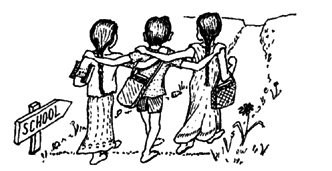
Early stimulation
As Rani's grandmother realized, a child who is blind has all the same needs as other children. She needs to be loved, not pitied. She needs to get to know the members of the family, and other things, by touch, sound, smell, and taste. The whole family can help her to become more aware of her home, and the things that are going on around her.
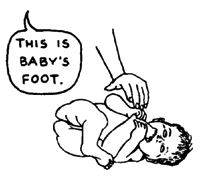
A baby's first plaything is her own body. Since she cannot see her hands and feet move, you may need to help her to feel, taste, smell, and explore them. |
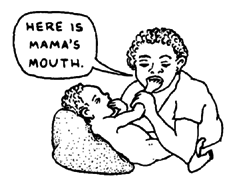
Have him compare by touch and sound his own and other people's faces so that he begins to recognize different people. |
Activities to help a child develop early skills more quickly are discussed in Chapter 35, Page 301 to 318. Most of these activities can help a blind child. But because he cannot see, he will need more stimulation in other areas, especially sound and touch, and in beginning to reach toward things and move about. Use toys and playthings that have many different shapes, feel different to touch, and make different sounds (see Page 468 to 476).
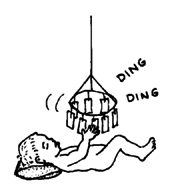
At first you may need to place the toy in the child's hand, or guide his hand to it. Or hang different things near him so that when he moves his hands they touch them. |
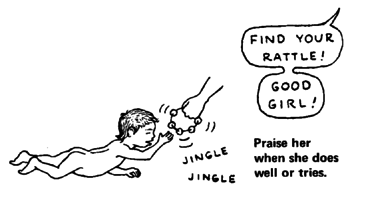
At each stage of the child's development, attract her attention with a noisy plaything. Have her reach for it and then try to move toward it. |
In addition to special activities, be sure the child spends most of each day in a situation where she can keep learning about people and things. In everything you do, talk to her, tell her the names of things, and explain what you and she are doing. At first she will not understand, but your voice will let her know you are near. Listening to words and names of things will also prepare her for learning language skills.
|
Talk to the child as you do housework Tell her what makes the sound she hears.
|
|
Sing to the child and encourage him to move to music. Also encourage blind children to make their own music.
For ideas on homemade musical instruments, see Page 469. |
|
Take the child outside often: to the market, the river, the cowshed, the village square. Show and explain different things to him, and tell him what makes different sounds. |
For a blind child, it is important that special help and stimulation start early - in the first months of life. Without this the child will fall far behind in her development. She may become quiet, not do much, and be afraid to move about. So her family does not expect much of her, or provide many learning opportunities. As a result, she falls still farther behind.
However, if a blind child has the stimulation and help she needs from an early age, she will develop many skills as quickly, or nearly as quickly, as a child who sees. So her family expects more of her and includes her more in their activities. As a result, she may develop almost as quickly as other children her age. She can probably enter school when they do.
Helping the blind child learn to move about
The child who is blind often is slow at learning to move about and will need extra help and encouragement. Some of the activities in Chapter 35 for creeping, crawling, standing, and walking will help. Here are some other suggestions.
When the child is beginning to scoot or crawl, you can leave toys and other interesting things in different places where he will find them. This will encourage him to explore and discover.
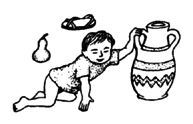
But when the child begins to walk, try to keep everything in its place, so that she does not bump into things unexpectedly and can gain more confidence moving about. If you change the position of something, show her where it is.
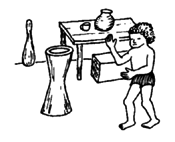
Play games and do exercises that will help the child gain confidence in moving and using his body.
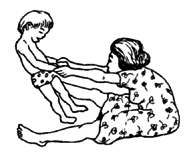
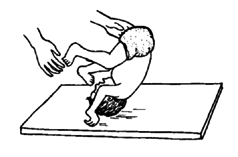
Encourage the child to make adventure, explore, and do all the things a child normally does. Protect her from hurting herself-but do not protect her too much. Remember, all children learning to walk sometimes fall. A blind child is no different.
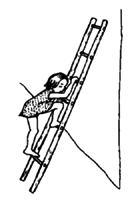
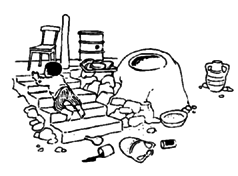
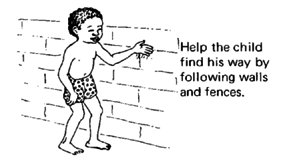
|
The child can learn to feel the edge of the path with her feet, and to feel plants or other objects with her hands. |
|
If the child does not start walking without help, let him start by pushing a simple walker, chair, or cart. Do not force the blind child to walk alone before he is ready. One day he will start walking alone, first a few steps only, but finally with confidence. |
Helping the blind child find her way without holding on
Outside the home, often a blind child will let you lead her by the hand, but may be afraid to take steps or try to find her way alone.
To help her begin to walk alone, first lead her over the area where you want her to walk. Show her and let her feel the different landmarks (posts, trees, bushes, houses) along the way.
|
A good way to guide a child by the hand is to let her hold one finger and walk a step behind you.
|
|
Now walk over the same path, but this time walk backward in front of her, and talk to her while you are walking.
|
|
When she feels comfortable with your walking in front of her, start walking behind her. Have her tell you the landmarks.
|
Little by little make yourself less and less needed. Speak less and let her go farther away from you.
Finally let her go the whole way alone. Start by having her walk short distances. Then gradually go farther, with more turns and other things to remember.
When she has progressed this far, the child will have the joy of knowing she can solve some problems alone. She will be ready to learn new things, meet other difficulties, and explore new areas.
|
The child needs to learn to 'see' with her feet, and to be prepared for unexpected things in her way. Play games with her. Tell her you have put some things in her path. See if she can get past them without slipping or falling. |
|
Sometimes the child will fall. Have her practice this by failing on soft ground. Teach her to put out her hands and bend her knees as she falls. She will be less likely to hurt herself.
|
|
Help the child to recognize how the sound of her footsteps (or her stick) changes when she is near a house or wall, and when there is open space. With practice, she can learn to tell the distance from things by the sounds. |
Learning to use a stick
Using a long stick can help a child find his way and give him more confidence, especially for walking in places he is not familiar with. With practice, it can also help him to walk in a faster, more normal way, with long, sure steps. This is because he can feel farther ahead of him with his stick than with his feet. The best age to start teaching a child to use a stick is probably about 6 or 7.
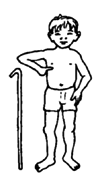
The stick should be thin and light, and tall enough so that it reaches half way between the child's waist and shoulders. The top of the cane can be curved or straight.
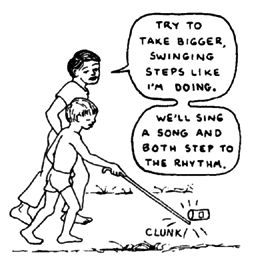
At first just give the child the stick and have him lightly touch the ground in front of him as he walks. His arm should be straight.
Play games letting him feel his way. But do not hurry him. Stop before he gets tired of it. At first, 5 or 10 minutes is enough.
After he gets used to the stick, walk beside him and encourage him to take smooth, even steps.
Have him swing the stick from side to side, and see if he can find things in his path.
After a time he can learn to use the stick better:
|
Move the stick from side to side, lightly touching the ground. The width of the swing should be a little more than the width of his shoulders. As the stick touches to one side, move the foot on the other side forward. |
|
On a narrow path or rough ground, someone can lead the child by the stick. Or the child can hold the person's elbow or wrist. |
|
The child can learn to feel the height of steps and curbs, and then to climb them. To go up steps, it is better to hold the stick like this to feel the position of each step.
|
|
Do not hold it like this. This can cause the cane to stop suddenly and hit the child in the stomach.
|
|
Teach the child to listen carefully before he crosses a path or road where cars or other traffic pass. Putting posts or other markings where roads or paths cross can help the child find his way or know where to turn. But whenever possible, teach him to find his way using 'landmarks' that are already there. |
|
Sometimes putting a guide rope or rail can help the child find his way. |
Helping the blind child to use his hands and to learn skills
Help the child who cannot see well to do all kinds of things with her hands, including daily care of herself.: eating, dressing, bathing, and toileting. Ideas for learning these skills are in Chapters 36 to 39.
At first you may need to help the child feel things by guiding his hands.
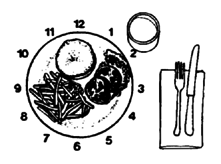
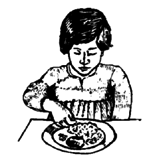
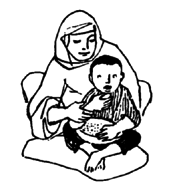
To help the child know where to look for the different foods on her plate, try to always put them in the same place. As the child gets older and learns to tell time, have her think of the plate or bowl as a clock. Tell her at what time each type of food is put on her plate. Here the glass of water is at 2 o'clock. Always put it at 2 o'clock.
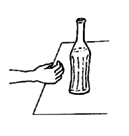
Help the child learn to put in the same place glasses, cups, bottles, and other things that can be easily spilled or broken. Teach her to remember where she puts things, and learn how to reach out for something and find it without knocking it over. Reaching out with the back of the hand causes less spilling. (This will take practice and there will be accidents, but that is the way she learns. Do not hand her everything or do everything for her, just to avoid a mess. Making a mess is part of learning.)
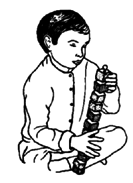
Help the child learn to recognize different shapes, sizes, and the 'feel of things' with her fingers. Let her play with toys and puzzles so that she learns to put different pieces together in a certain pattern or order. Ideas for toys and puzzles are on pages 468 to 476.
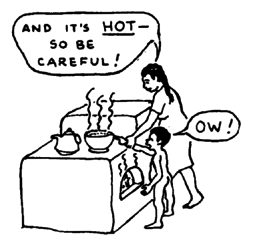
Teach the child about things he must be careful with or keep a distance from, to not get hurt: things such as fire, hot pans and dishes, sharp knives, dogs and mules that might bite or kick, deep holes, wells, cliffs, deep ponds or rivers. Do not just tell him "No!" Help him to understand the danger.
|
CAUTION: Whenever possible, keep dangerous things out of reach or put fences around them, and take other precautions to protect the child -especially until he is old enough to be careful. |
Give the child opportunities to begin to help in different ways around the house. This will both increase her skills and give her a sense of being part of the life and action of the family.
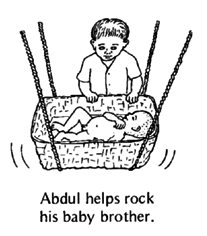
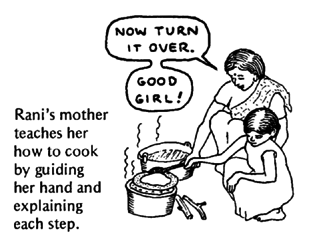
When the child has learned to handle bigger things fairly well, help her learn to feel and handle smaller things. For example:
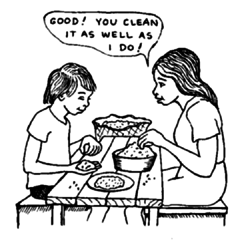
She can help sister pick the little stones and bits of dirt out of the rice.
If someone takes the time to teach him, a child can begin to help in a lot of things around the home, and also in village crafts. Weaving of mats, rugs, clothing, and baskets are things many blind children can learn to do well, and it helps them learn to use their hands skillfully.
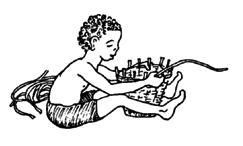
Also, look for games and toys that help the child develop her ability to feel fine details and small shapes with her fingers.
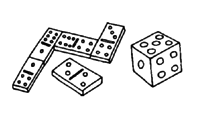
For example, you can make dominos and dice out of wood. For the dots, hammer round-headed nails into the wood, so she can feel them. Or drill holes.
The child can learn to feel the dots with her fingertips. At the same time, she will begin to learn to count and use numbers.
You can start with 'giant' dominos and dice, and when her fingers learn to feel more skillfully, change to small ones. This will be good preparation for doing many kinds of fine work and perhaps for learning to read braille.
SCHOOL
Blind children should have the same opportunity as other children to go to school. Ideas for how children in the community can help a blind child get to school, and help her in the classroom and with her studies are discussed in the CHILD-to child activity on blindness (see Page 449).
In most countries there are special schools that teach blind children to read and write 'braille'. Braille is a system of raised dots that represent letters and can be read with the fingertips. It was invented many years ago by a blind boy from France named Louis Braille.
Most village children do not learn braille in school. However, there are many other ways that they can learn in school.
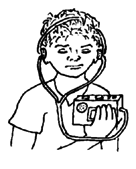
For the blind village schoolchild, one of the best aids for taking notes and reviewing lessons is a small tape recorder. The family should try to save money to buy one. Or perhaps the schoolchildren can hold a raffle or collect money to buy one. Other children can help record lessons from school books, and stories and information from other books.
|
Louis Braille invented this dot alphabet at age 14. |
|
IMPORTANT: In order to keep up with her studies a blind child will need help. In school another child can read to her from her books. The child may also need extra help after school. An older brother or sister, or another schoolchild, can perhaps spend time teaching her at home. |
Remember, most 'blind' children have some useful vision. Encourage the child to use whatever sight she has. If she can see big letters on the blackboard, write big and clear, and be sure she sits in the front. Be sure the light is good, and that dark letters and things stand out against a light background.
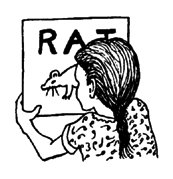
If she can see at all, to help her learn the letters, make them very BIG. Use white paper and dark ink.
To help the child learn the shape of letters by feel, you could make them in one of these ways.

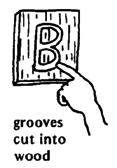


|
In the schoolroom, a pan with soft clay or mud is helpful for learning to write and feel letters. |
|
Children can practice writing outside in sand, mud, or clay. |
|
When the child begins to write, you can stretch string lines across the paper to help her write in straight lines. Or draw extra dark lines. |
To help the child begin to count you can make a simple 'counting frame'. The child can slide the beads or rings from one side to the other to count, add, and subtract.
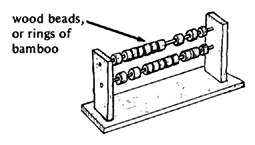
When the child becomes more skilled with numbers, she can learn to use a special counting frame called an 'abacus' which has beads on wires. The beads slide up and down to form numbers. With practice, a blind child can learn to add and subtract on the abacus as fast or faster than other children can do it on paper.
A pegboard like this can help a child learn numbers through touch- and help him learn to feel small differences in things.
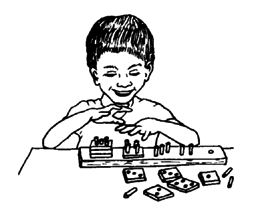
AN ABACUS
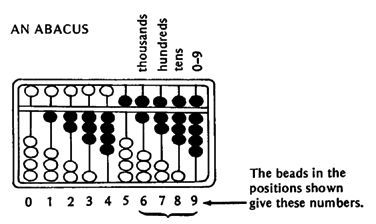
(All the beads are really the same color. Here we have made some black to make it clearer how to count.)
Work
As a blind child grows up, he or she can learn to do many different kinds of work. On page 509 in Chapter 54 we list many of the different kinds of work that disabled persons can do. Those types of work marked with a * have often been done by blind persons.
The village child who is blind should be given many opportunities to help with work around the home and with farm work. The blind child should be invited and expected to help in a wide range of daily activities, just like the child who can see. What starts out as play and imitation ends up as learning of useful skills.
A family that farms the land can begin to include a blind child in gardening and farming activities from an early age.
|
To get an understanding of the whole process of growing the family food, the child can start by planting seeds, watering them, caring for them as they grow, and finally harvesting, cooking, and eating the product. |
|
Later, the child can go with his father or mother to the fields and help with the planting. With his feet he can follow the furrows, or grooves made by the plow. |
Try to involve the child with each aspect of housework and farm work. At first show her and guide her as much as is necessary. Then help less and less until finally the child can do the whole job alone.
Social life
The blind child should have all the same opportunities in the community as other children do. Take her with you, and then send her, to the market, well, river, school, and temple. Introduce her to the people you meet. Explain to them that she is an active little girl like any other, except that she cannot see. Ask them, when they see her, to make a point of speaking to her (since she cannot see them), of answering her questions, of helping her to find what she is looking for. Ask them not to do everything for her, but instead to help her figure out how to do more for herself. Little by little people will begin to realize that a blind child can do a lot more than they would ever have dreamed possible. And they will begin to respect and appreciate her. For the next blind child in the village, it will be easier.
Take the child to meetings, movies, puppet shows, and town events. Explain to her what she cannot see.
When children who are blind grow up, they can marry and have children. They can be as good parents as persons who see.
PREVENTION of blindness
The best way to prevent blindness is to try to keep children well fed, clean, and healthy. During pregnancy, mothers also need to eat enough nutritious foods and to avoid medicines that might damage the baby. Specific steps to prevent some causes of blindness have already been discussed.
In brief, steps to prevent child blindness include:
-
When pregnant, keep away from persons with German measles and other infectious diseases, avoid unsafe medicines, and try to get enough to eat.
-
Protect the eyes of all newborn babies with tetracycline eye ointment or 1 % silver nitrate drops at birth (see Page 245).
-
Vaccinate children against all the infectious diseases you can.
-
Breast feed the baby, and continue to breast feed as long as possible.
-
Good nutrition for mother and child-especially foods rich in vitamin A. Children often get diarrhea and then 'dry eyes' after they are taken off the breast. So, when the baby starts to eat other foods, give him mashed papaya, mashed cassava leaves, or other foods with vitamin A, every day.
-
Keep the home and child clean. Build and use latrines, and keep them covered. Try to protect against flies. Wash hands with soap and water, especially before eating and after using the latrine (toilet).
-
Keep the child's eyes clean. When they get infected or have pus, clean them often with a clean cloth that is wet with clean water, and see a health worker.
-
Give children with measles vitamin A rich foods (or vitamin A capsules, see Page 244) because danger of 'dry eyes' increases with measles.
-
Treat all persons with signs of trachoma early. For treatment of different eye problems, see a health worker or get information from a book like Where There Is No Doctor.
-
Keep sharp and pointed objects, bullets, explosives, acids, and lye away from children and teach them about their dangers. Warn them about the danger of throwing closed bottles, cans, or bullets into the fire. Also warn them about local plants that can injure the eyes. (For example, the juice of 'hiza', a poisonous fig tree in Mexico, can burn the eyes like lye.) Get good early treatment for any eye injury.
-
Warn children about throwing rocks and sticks, or shooting slingshots toward other persons.
-
Check babies and children for early signs of eye problems or difficulty seeing. Test how well they can see at 2 months of age and before they begin school.

-
Organize children to test the sight of their younger brothers and sisters (see CHILD-to-child, Page 452).
-
Help everybody understand that most blindness in children can be prevented. Teach people what they can do.
-
For special precautions to protect the eyes of persons who have a loss of feeling in their eyes, see Chapter 26 on Leprosy, Page 223.
Disabled Village Children
A guide for community health workers,
rehabilitation workers, and families
by David Werner
Published by
The Hesperian Foundation
P.O. Box 11577
Berkeley, CA 94712-2577

